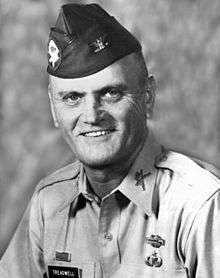Jack L. Treadwell
| Jack L. Treadwell | |
|---|---|
 | |
| Born |
March 31, 1919 Ashland, Alabama |
| Died | December 12, 1977 (aged 58) |
| Place of burial | Fort Sill Post Cemetery near Lawton, Oklahoma |
| Allegiance |
|
| Service/branch |
|
| Years of service | 1941 - 1974 |
| Rank |
|
| Unit | 180th Infantry Regiment, 45th Infantry Division |
| Battles/wars | World War II |
| Awards |
Medal of Honor Distinguished Service Cross Silver Star Legion of Merit (3) Bronze Star |
Jack LeMaster Treadwell [1] (March 31, 1919 – December 12, 1977) was a United States Army officer and a recipient of the United States military's highest decoration—the Medal of Honor—for his actions in World War II.
Career
Treadwell joined the Army from Snyder, Oklahoma in January 1941,[2] and by March 18, 1945 was serving as a first lieutenant in command of Company F, 180th Infantry Regiment, 45th Infantry Division. During a battle on that day, near Nieder-Wurzbach in Germany, Treadwell single-handedly captured six German bunkers. He was subsequently promoted to captain and, on September 14, 1945, awarded the Medal of Honor. According to Signal Corps photo 210821, Treadwell received his MOH from President Truman on 23 August 1945.
He graduated from Snyder, Oklahoma High School in 1937 and attended Southwestern State College, Weatherford, Okla. in 1937 and 1938. He is a graduate of the University of Omaha class of 1963,[3] Nebraska. Treadwell reached the rank of colonel before leaving the Army in 1974.[4] He died at age 58 and was buried at the Fort Sill Post Cemetery near Lawton, Oklahoma.
Medal of Honor citation
Captain Treadwell's official Medal of Honor citation reads:
Capt. Treadwell (then 1st Lt.), commanding officer of Company F, near Nieder-Wurzbach, Germany, in the Siegfried line, single-handedly captured 6 pillboxes and 18 prisoners. Murderous enemy automatic and rifle fire with intermittent artillery bombardments had pinned down his company for hours at the base of a hill defended by concrete fortifications and interlocking trenches. Eight men sent to attack a single point had all become casualties on the bare slope when Capt. Treadwell, armed with a submachinegun and handgrenades, went forward alone to clear the way for his stalled company. Over the terrain devoid of cover and swept by bullets, he fearlessly advanced, firing at the aperture of the nearest pillbox and, when within range, hurling grenades at it. He reached the pillbox, thrust the muzzle of his gun through the port, and drove 4 Germans out with their hands in the air. A fifth was found dead inside. Waving these prisoners back to the American line, he continued under terrible, concentrated fire to the next pillbox and took it in the same manner. In this fort he captured the commander of the hill defenses, whom he sent to the rear with the other prisoners. Never slackening his attack, he then ran across the crest of the hill to a third pillbox, traversing this distance in full view of hostile machine gunners and snipers. He was again successful in taking the enemy position. The Germans quickly fell prey to his further rushes on 3 more pillboxes in the confusion and havoc caused by his whirlwind assaults and capture of their commander. Inspired by the electrifying performance of their leader, the men of Company F stormed after him and overwhelmed resistance on the entire hill, driving a wedge into the Siegfried line and making it possible for their battalion to take its objective. By his courageous willingness to face nearly impossible odds and by his overwhelming one-man offensive, Capt. Treadwell reduced a heavily fortified, seemingly impregnable enemy sector.
See also
Notes
References
- "Jack L. Treadwell". Claim to Fame: Medal of Honor recipients. Find a Grave. Retrieved 2007-10-03.
- "Medal of Honor recipients - World War II (T–Z)". Medal of Honor citations. United States Army Center of Military History. June 8, 2009. Retrieved 2007-10-03.
|